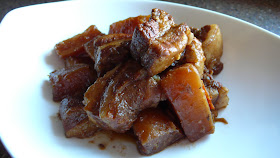Every year my friends and I get together with all our lady friends for a picnic at Hyde Park (North Perth).
This year the third annual ladies picnic was held on Good Friday 22 April. The picnic is generally held earlier on in the year in February or March but so much stuff has been happening that the date kept getting pushed back and with the never ending hot and dry spell in Perth at the moment, there was still some fine picnicking weather coming into April. The weather last Friday was perfectly nice and sunny, in the low thirties.
The picnics are usually filled with so many sweet baked goods that I think I use up my quota of sugar intake for the month within one afternoon. With the ladies picnic coinciding with Easter this year as well, I was wary of the potential for people to lapse into a sugar coma with a five day long Easter weekend of sugar intake to account for.
I wanted to bring something non-sweet to the picnic this time and found a recipe for a savoury cupcake from the Globe and Mail – a recipe for a rosemary and roasted-pepper cornbread cupcakes with cream cheese icing. I liked the fact that these looked deceptively like real cupcakes complete with frosting and all, but when you bite into them you get a mouthful of herbs, roasted capsicum and corn, rounded off with cheese. It’s a surprising and really tasty combination of ingredients and everyone at the picnic really enjoyed these cupcakes. Here is the recipe.
Ingredients
Cupcakes:
• 2 eggs
• 1 cup creamed corn
• 200g sour cream
• ¼ cup vegetable oil
• ½ cup all-purpose flour
• ½ cup yellow cornmeal
• ¼ cups granulated sugar
• 2 tablespoons baking powder
• 1 teaspoon salt
• 1 tablespoon coarse black peppercorn
• 2 tablespoons chopped parsley
• 2 teaspoons chopped rosemary
• 1 bunch chopped chive (approximately ¼ cup)
• ½ cup roasted red peppers, patted dry and coarsely chopped
Icing:
• 1 cup cream cheese
• ½ cup chevre
• 3 tablespoons finely chopped red bell pepper
• 2 tablespoons chopped chives
The cornmeal was quite hard to find. I went to the usual suspects – Woolworths, Coles, IGA and none of them sold cornmeal, and when I asked Fresh Provisions if they had any cornmeal I was taken to the polenta section and told that this is what I was looking for. I have never used cornmeal before but I was sure that polenta and cornmeal were not the same thing. My last stop was Antonio’s Continental Store and I finally found some cornmeal. The interesting thing was that when I told people at the picnic that I had used cornmeal in the cupcakes, people would respond with “oh you mean polenta”. It appeared that some people mistake polenta for cornmeal and had used polenta in the place of cornmeal in recipes. Is this a common mistake? Is there a difference? Cornmeal is much finer than polenta.
Method
Preheat oven to 350 F (about 176.67 degrees celsius). In a large bowl combine eggs, creamed corn, sour cream and oil. In separate bowl combine flour, cornmeal, sugar, baking powder and salt. Add dry mixture to wet mixture and blend evenly. Stir in the parsley, green onions, rosemary and the roasted red peppers.
(Was a bit concerned about the addition of a whole tablespoon of black pepper as generally I’d be adding a pinch here and here, but it was the right amount for the cupcakes and not overwhelming.)
There were lots of baked goods at the picnic including a prototype wedding cake my friend was developing for her sister’s wedding that we got to sample and the classic flourless orange almond cake.
What’s the time Mr Wolf?
What’s the time Mr Wolf?
What’s the time Mr Wolf?
Dinnertime!






























































